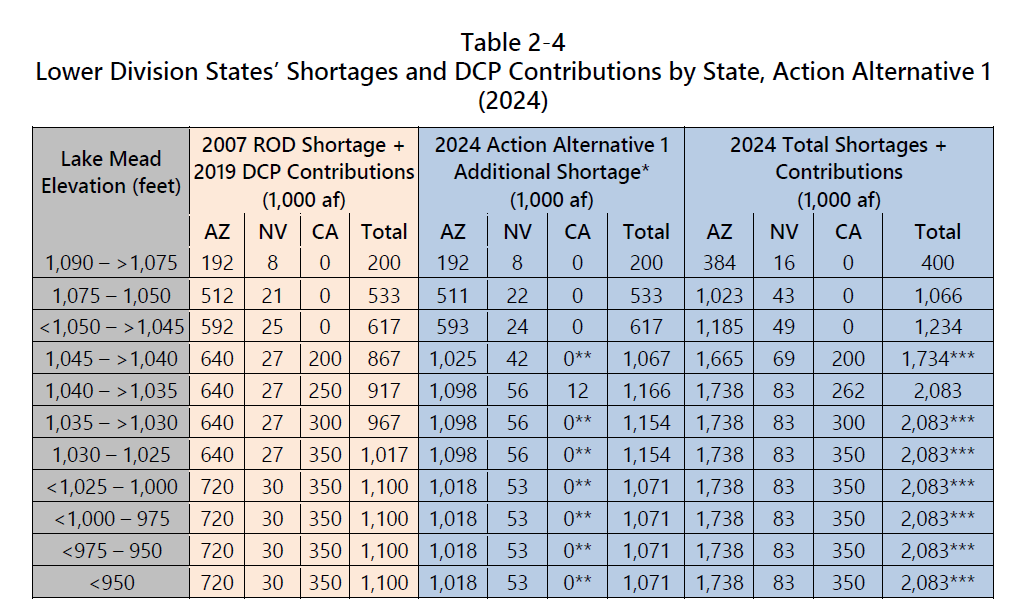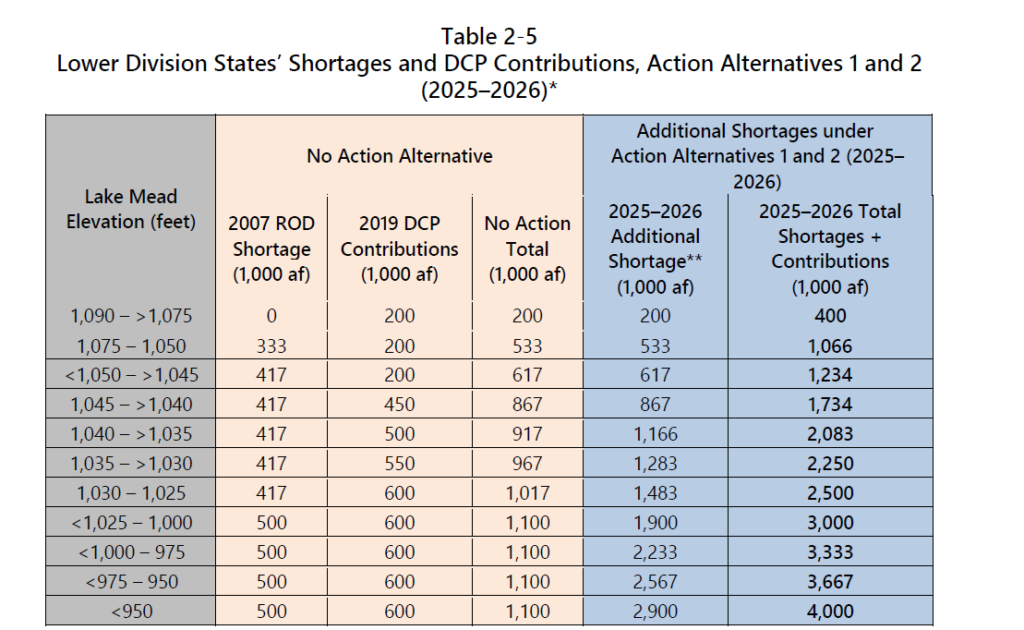Last updated 2 p.m. MDT April 12, 2023 – with explanation of why the feds’ cut isn’t as deep as the states’
I’ll need a few more days to digest all 476 pages of the Department of Interior’s Colorado River Draft Supplemental Environmental Environmental Impact Statement, but the top line numbers are worth sharing right away. The DEIS includes a couple of action alternatives, which I’ll briefly describe below, but what’s immediately striking to me is that Interior’s cuts are significantly less ambitious than the states’. Here’s a quick update of the table I built back in January comparing the proposal submitted by Arizona/Nevada/Utah/Colorado/New Mexico/Wyoming, and the California plan.
As you can see, the states were far more willing to cut more quickly, and more deeply, than the federal alternatives. The numbers are cuts, in thousands of acre feet, from the old pre-chaos baselines of 4.4 maf for California, 2.8 maf for Arizona, 300kaf for Nevada.
| Tier | Elevation | 6-state | California | DEIS 2024 | DEIS 2025-26 |
| Tier 0 | 1090 | 1,784 | 1,241 | 400 | 400 |
| Tier 1 | 1075 | 2,156 | 1,613 | 1,066 | 1,066 |
| Tier 2a | 1,050 | 2,918 | 1,721 | 1,234 | 1,234 |
| Tier 2b | 1045 | 2,918 | 2,013 | 1,734 | 1,734 |
| Tier 2c | 1040 | 2,918 | 2,071 | 2,083 | 2,083 |
| Tier 2d | 1035 | 2,918 | 2,129 | 2,083 | 2,250 |
| Tier 2e | 1030 | 3,168 | 2,188 | 2,083 | 2,500 |
| Tier 3a | 1025 | 3,168 | 2,525 | 2,083 | 3,000 |
| Tier 3b | 1020 | 3,368 | 2,675 | 2,083 | 3,333 |
| Tier 3c | 1015 | 3,368 | 2,875 | 2,083 | 3,333 |
| 1,010 | 3,368 | 3,125 | 2,083 | 3,333 | |
| 1,005 | 3,368 | 3,325 | 2,083 | 3,333 |
I’m told the reason the feds’ initial cuts are less than in the states’ proposals is because 2.083 maf is the lowest they can go next year and still be in compliance with their NEPA/SEIS coverage for Lower Colorado River operations.
In addition to the, “whatever, let’s just crash the system”, the DEIS includes two alternatives….
Priority administration
Alternative one would allow the cuts in my “DEIS” column based on the priority system. This plan is similar to California’s, in that the brunt of deep cuts falls on others. At current reservoir levels, Arizona would be required to cut 1.2 million acre feet, while California cuts nothing.
Sharing the impacts of climate change
Alternative two would spread additional needed cuts based on a pro-rata share of 2021 water use among all the users. At current levels, Arizona would cut 1.025 million acre feet, California would cut 1.067.
How it plays out
Contrary to that crazy New York Times headline (click soon, it’ll certainly change!) Interior isn’t picking a preferred alternative. These are really just starting points for a push toward a seven-state negotiation between now and summer.
Here’s how it plays out in 2024:

Table of Cuts
Future years:
In subsequent years, the cuts go deeper:

2025-26 cuts

Wait for it, table 3-2.
Thanks for doing the deep dive. Always helpful.
I’m not surprised with Interior’s DEIS numbers. They, dispite what their leadership sometimes says, understand the situation regarding interstate disagreements. Since any questions the go directly to SCOTUS, and they famously do not like breaking precedent, Interior will err on the side of the standing compacts. I know no one (outside of California) likes that, but that is a reality everyone must live with.
A longer, drawn out discussion, that has compromise and gets agreement from all 7 states is what will work better than almost any alternative. I’m with Delph Carpenter on that idea.
If the Feds are coming in under the States, would that make it more likely that the States will feel less pressure now to push for deep cuts? I mean, if the Federal government doesn’t think this is a screaming emergency then many stakeholders in basin states will have ammunition now to push for lower cuts.
Would you agree with that?
Plus, this snow season will give the drought deniers plenty of excuses to ignore the trend.
Sounds like a recipe for disaster.